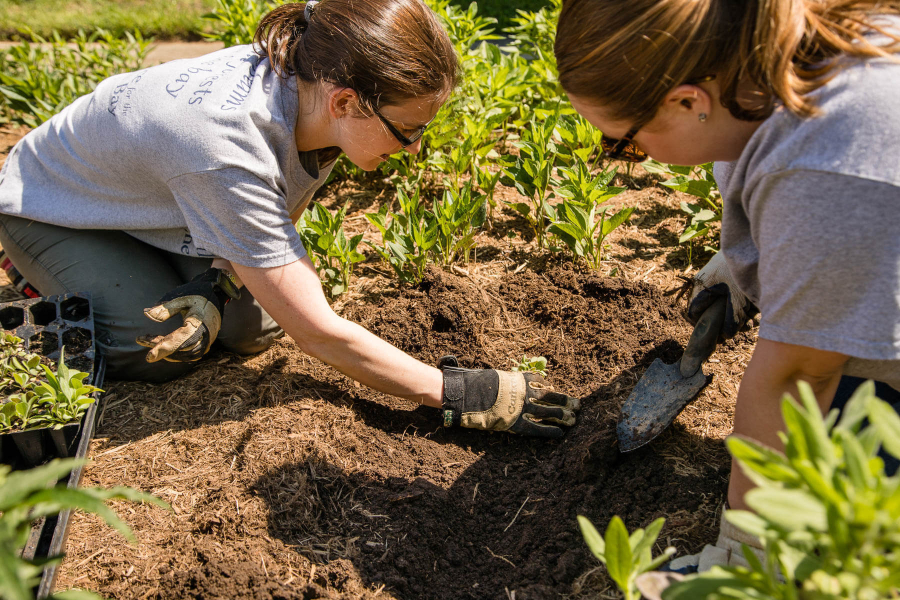Eight things environmentalists do to help the Chesapeake Bay
We sent our staff a survey asking them about the types of positive activities they do for the Bay when they're not at work.

The Chesapeake Bay Program’s staff is on a mission to restore the Bay and its rivers. Whether they work on water quality, education or oysters, everyone here is dedicated to helping the Chesapeake. But do they keep the Bay in mind when they aren’t behind their desk?
A few months ago, we sent our staff a quick survey asking them about the types of positive activities they do for the Bay when they’re not at work. Some results were typical, while others were unique. The following eight activities were the most popular:
1. Recycle
Is anyone surprised that recycling ranked as the number one thing Bay Program staff do to help the Bay? Recycling is one of the easiest things you can do for the environment. One of the most common reasons why people don’t recycle is because their location does not offer recycling services. If you’re having trouble finding recycling services in your, enter your area code at Earth911 for a listing of drop-off locations near you.
2. Use little or no fertilizer on their lawn
You know you work with environmentalists when fertilizer use ranks near the top of the list! The average person may not realize that yard runoff containing fertilizer can be harmful to local waterways and the Chesapeake Bay. Fertilizer is full of nutrients, which fuel the growth of algae blooms that block sunlight from reaching bay grasses and rob the water of oxygen. To learn more about Bay-friendly tips in your yard, check out our How-To's and Tips.
3. Compost
A little more than half of respondents said they composted at home on a regular basis. Composting is a great way to save time, money and the Bay. When you compost things like kitchen scraps and leaves, you are not only creating your own free fertilizer, but you are reducing the amount of waste that goes to landfills. Old composters used to require a pitchfork to turn over the pile, but these have been replaced with easy-to-use bins with hand cranks. To help you get started with composting, learn how to construct a compost pile.
4. Have a Bay license plate
If you live in or have driven through Maryland, you have probably noticed the iconic blue Chesapeake Bay license plate. What many people don’t know is that the proceeds from this “vanity plate” go to the Chesapeake Bay Trust, a non-profit that conducts restoration, education and community engagement activities throughout the Bay watershed. To date, the Trust has planted 220,648 native plants and trees, restored 65 acres of wetlands, oyster reefs and streamside buffers, and engaged 86,717 students.
5. Volunteer for restoration projects at least once a year
All the funding in the world for restoration projects will not help if there is no one to do the work! There are an overwhelming amount of opportunities to get involved with environmental organizations in our region. From planting trees to removing invasive species to building oyster reefs, there are activities for every interest. Volunteering is also a great way to get your kids outside and help them appreciate nature. If you are interested in getting your family involved, contact your local watershed organization for more information about opportunities near you.
6. Have a rain garden or a rain barrel
Rain barrels and rain gardens are important because they collect water from roofs, yards and paved surfaces that would otherwise flow into storm drains. Rain gardens and rain barrels are so important that some counties actually offer funding and tax breaks for implementing them. Check with your city environmental office to see if your area has a program, or learn how to build your own rain barrel.
7. Pick up after their pets
It is common misconception that it’s safe to leave pet waste on the ground because some consider it a “natural fertilizer.” However, pet waste actually contains harmful nutrients and bacteria that can run off into local waterways. Some areas can be closed off to swimmers in summertime due to high bacteria levels from pet waste. Dog waste should be thrown away, flushed or put in a pet waste composter.
8. Carpool to work
People tend not to carpool because they do not know if anyone else who works with them lives nearby. People also enjoy the freedom of being able to come and go as they please without having to worry about altering their schedule because of another carpool rider. However, carpooling can actually save you time and money. You will spend less on gas and vehicle maintenance, and you can take advantage of High Occupancy Vehicle (HOV) lanes.
The best solution is to create a way for colleagues who are interested in carpooling to list where they live. Put it in a well-traveled place, such as a kitchen, front desk or break room.
After seeing what the “average environmentalist” does for the Chesapeake Bay, do you think you do the same? Or more? What activities do you do that help the Chesapeake?

Comments
Dog feces contains a lot of the same nutrients that pollute the watershed, in addition to harmful bacteria and worms and other biohazards. As a benefit, you don't have to worry about scraping it off your shoes after mowing the lawn. In addition to help with air quality, driving less results in fewer emissions that contribute to a third of the excess nitrogen flushed into the bay every year. Consolidate trips, carpool, use public transit or bike or walk when you can.
Thank you! This is very helpful!
NICE JOB!!!!!!
Thank you!
Your comment has been received. Before it can be published, the comment will be reviewed by our team to ensure it adheres with our rules of engagement.
Back to recent stories